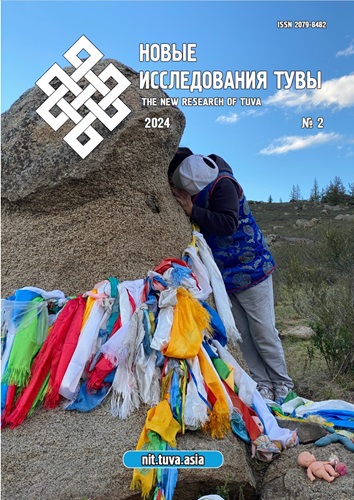Rural-urban interaction in Tuva (based on interviews with natives of the Ovyursky District)
DOI:
https://doi.org/10.25178/nit.2024.2.13Keywords:
Tuva; Tuvans; Kyzyl; Ovyur; rural-urban; shepherd's camp; food; relatives; dagylgaAbstract
The article analyzes the characteristics of rural-urban interactions in the Republic of Tuva. The study was based on semi-structured in-depth interviews conducted in Ovyursky District in 2022 with rural and urban residents, as well as former rural residents who have now become urban residents.
One of the key features of rural-urban relations in Tuvan society is their intensity, which is reflected in the density of interactions between rural and urban inhabitants. Drawing on D. K. Lynch's concept of rural-urban flows, the author identified several main types: economic food transfers from rural areas to cities, seasonal labor migration from cities to villages, educational transfers of schoolchildren from villages to cities, and ethnocultural exchanges from cities to rural areas. Dense informal economic interaction occurs primarily due to the maintenance of a shared shepherd's parking lot. There is an exchange of food and labor between relatives who participate in this activity. In Tuvan villages, the practice of sending children to urban schools with relatives is common, leading to overcrowding in urban education institutions. In turn, rural areas provide an important spiritual component for city dwellers, giving them a sense of sacredness and a place where they can preserve the Tuvan language and culture.
The author argues that due to rural-urban interactions, residents are attempting to overcome socioeconomic challenges and compensate for the lack of social benefits and institutional support.
References
Avdeeva, T. T. and Skripil', I. A. (2018) Interaction of urban and rural territories in the economic space of the region. Krasnodar, Kubanskii gosudarstvennyi universitet. 170 p. (In Russ.).
Anaiban, Z. V. (2018) Employment and socio-professional orientations of contemporary Tuva’s youth. New Research of Tuva, no. 2, pp. 112–131. (In Russ.). DOI: https://doi.org/10.25178/nit.2018.2.6
Bitkeeva, A. N. and Tsybenova, Ch. S. (2022) Chronicle of the Tuvan language shift in the Republic of Tuva. New Research of Tuva, no. 4, pp. 6–27. (In Russ.). DOI: https://doi.org/10.25178/nit.2022.4.1
Galindabaeva, V. V. (2014) Intergenerational care in rural migrant families in Buryatia: gender aspect. Teoriia i praktika obshchestvennogo razvitiia, no. 18, pp. 35–37. (In Russ.).
Galindabaeva, V. V. (2015) The ideology of extended motherhood: caring for the children of rural migrants in Buryatia. Zhurnal issledovaniia sotsial'noi politiki, no. 1, pp. 7–20. (In Russ.).
Dabiev, D. F. (2018) Career preferences of Tuva population in the context of economic culture. New Research of Tuva, no. 2, pp. 132–148. (In Russ.). DOI: https://doi.org/10.25178/nit.2018.2.7
Dagylga: Tuvan rites of consecration in the XXI century (2021) / ed. by Ch. K. Lamazhaa and N. D. Suvandii. Kyzyl, s. n. 188 p. (In Russ.).
Darzhaa, Ch. B. and Taibyl, R. S. (2019) Livestock farms in the Republic of Tyva. In: The competitive potential of the region: assessment and efficiency of use : collection of articles of the X International Scientific and practical Conference / ed. by N. F. Kuznetsova. Abakan, Khakasskii gosudarstvennyi universitet im. N. F. Katanova. 284 p. Pp. 62–64. (In Russ.).
Dulov, V. I. (1951) Remnants of the communal-tribal system and tribal way of life among Tuvans in the XIX — early XX century (before 1917). Sovetskaia etnografiia, no. 4, pp. 57–76. (In Russ.).
D'iachkova, P. A. and Mosienko, N. L. (2021) The Analysis of Commuting Migrations within the Urban Agglomeration: Sociological Surveys and Big Data. World of Economics and Management, vol. 21, no. 4, pp. 205–228. (In Russ.). DOI: https://doi.org/10.25205/2542-0429-2021-21-4-205-228
Zimmel, G. (2018) Big cities and spiritual life: transl. from Germ. Moscow, Strelka Press. 12 p. (In Russ.).
Zykin, A. V. (2019) The problem of reviving the traditional culture of Tuvan ethnos during the post-Soviet period. Man and Culture, no. 1, pp. 23–31. (In Russ.). DOI: https://doi.org/10.25136/2409-8744.2019.1.28729
Koriukhina, I. Iu. and Kuklina, V. V. (2014) The interaction of the city and the village in the spaces of the suburbs (the case of Irkutsk). Labirint. Zhurnal sotsial'no-gumanitarnykh issledovanii, no. 3, pp. 14–21. (In Russ.).
Kuz'mitskaia, A. A. (2022) Interaction of city and village in modern society. In: Current issues of economics and agribusiness. Proceedings of the XIII International Scientific and Practical Conference / ed. by O. V. D'iachenko. Kokino, Brianskii gosudarstvennyi agrarnyi universitet. 638 p. Pp. 604–608. (In Russ.).
Kuular, S.-S. V. (2020) Value priorities of the modern tuvan family: research experience. Mir nauki, kul'tury, obrazovaniia, no. 6 (85), pp. 40–42. (In Russ.). DOI: https://doi.org/10.24412/1991-5500-2020-685-40-42
Kuular, S.-S. V. (2022) Traditions of kinship among tuvans as a factor of spiritual and moral education of the individual. Problemy sovremennogo obrazovaniia, no. 2, pp. 115–123. (In Russ.). DOI: https://doi.org/10.31862/2218-8711-2022-2-115-123
Lamazhaa, Ch. K., Kuzhuget, Sh. Yu. and Mongush, A. V. (2022) Khoi edi for Tuvans. Identity, convenience, responsibility. Etnografiia, no. 4 (18), pp. 151–174. (In Russ.). DOI: https://doi.org/10.31250/2618-8600-2022-4(18)-151-174
Lamazhaa, Ch. K. (2021a) The Main Issues of the Study of Kinship and Kin Groups of Contemporary Tuvans: Passportization, Terminology and Maintenance of Kinship. New Research of Tuva, no. 4, pp. 6–21. (In Russ.). DOI: https://doi.org/10.25178/nit.2021.4.1
Lamazhaa, Ch. K. (2021b) Social communities and social ties of Tuvans in the XIX — early XXI century. In: Ermolaev readings. Materials of the jubilee V scientific and practical conference with international participation dedicated to the 100th anniversary of the formation of the Tuvan People's Republic / ed. by V. S. Chigzhit. Kyzyl, Izdatel'skii otdel Natsional'noi biblioteki im. A. S. Pushkina Respubliki Tyva. 284 p. Pp. 7–10. (In Russ.). DOI: https://doi.org/10.24412/2686-9624-2021-7-10
Lamazhaa, Ch. K., Bicheldei, U. P. and Mongush, A. V. (2020) Tuvan Buddhist pilgrimage: from tradition to the faith. New Research of Tuva, no. 4, pp. 135–155. (In Russ.). DOI: https://doi.org/10.25178/nit.2020.4.10
Lushnikova, O. L. (2021) Altay people, Tuvans, Khakass people: involvement in urban processes. Oikumena. Regionovedcheskie issledovaniia, no. 3, pp. 113–125. (In Russ.). DOI: https://doi.org/10.24866/1998-6785/2021-3/113-125
Mainy, Sh. B. (2023) Perceptions of ‘cher’ (‘earth’) among contemporary Tuvans. New Research of Tuva, no. 1, pp. 38–63. (In Russ.). DOI: https://doi.org/10.25178/nit.2023.1.3
Mal-magan. Tuvans — cattle — meat (2023) / Ch. K. Lamazhaa, N. D. Suvandii, Ch. Kh. Sanchai, Sh. Yu. Kuzhuget, Sh. B. Mainy and A. V. Mongush; ed. by Ch. K. Lamazhaa and N. D. Suvandii. Kyzyl, s. n. 152 p. (In Russ.).
Migration processes in a modern city (2013) / ed. by M. V. Afonin and L. D. Rudenko. Yaroslavl, Yarosl. gos. un-t im. P. G. Demidova. 106 p. (In Russ.).
Nefedova, T. G. (2013) Ten topical questions about rural Russia. The geographer's answers. Moscow, Lenand. 456 p. (In Russ.).
Polian, P. M. (2014) Territorial structures — urbanization — settlement: theoretical approaches and methods of study. Moscow, Novyi khronograf. 785 p. (In Russ.).
Saaia, S. K., Tanzy, M. V., Safonov, K. V. and Shershneva, V. A. (2021) Mathematical training of schoolchildren and students in the Republic of Tuva under the conditions of bilingualism. Bulletin of Krasnoyarsk State Pedagogical University Named After V. P. Astafyev, no. 3 (57), pp. 17–26. (In Russ.). DOI: https://doi.org/10.25146/1995-0861-2021-57-3-286
Sevek, V. K., Taibyl, R. S. and Darzhaa, Ch. B. (2020) Analysis of the economic efficiency of typical ethnic farms of the Republic of Tuva. Nauchnye trudy Vol'nogo ekonomicheskogo obshchestva Rossii, vol. 223, no. 3, pp. 468–477. (In Russ.). DOI: https://doi.org/10.38197/2072-2060-2020-223-3-468-477
Smit, A. (2007) A study on the nature and causes of the wealth of nations. Moscow, Eksmo. 960 p. (In Russ.).
Taibyl, R. S. and Darzhaa, Ch. B. (2019) Modern problems of nomadic economy in an ethnic region (by the example of the Republic of Tuva). In: Problems of sustainable development of the region: collection of articles of the IX school-seminar of young scientists of Russia, dedicated to the 70th anniversary of Academician Arnold Kirillovich Tulokhonov / ed. by P. L. Paleev and E. Ts. Pintaeva. Ulan-Ude, Buriatskii nauchnyi tsentr Sibirskogo otdeleniia RAN (Ulan-Ude). 274 p. Pp. 57–60. (In Russ.).
Tatarova, S. P. and Zateeva, N. A. (2017) Social processes in modern Siberian villages (on the example of the Republics of Buryatia and Tuva). Ulan-Ude, Izdatel'sko-poligraficheskii kompleks FGBOU VO VSGIK. 192 p. (In Russ.).
Tatarova, S. P. and Zateeva, N. A. (2018) The education system as a factor in the development of rural society in the Republics of Buryatia and Tuva. Gumanizatsiia obrazovaniia, no. 6, pp. 29–34. (In Russ.).
Tennis, F. (2002) Community and society. Basic concepts of pure sociology: transl. from Germ. By D. V. Skliadneva. St. Petersburg, Vladimir Dal'. 452 p. (In Russ.).
Timoshenko, M. A. (2014) Interaction between cities and villages as a factor of economic growth in rural areas of the Southern Federal District. Ekonomika i upravlenie v XXI veke: tendentsii razvitiia, no. 14, pp. 124–130. (In Russ.).
Tinikova, E. E. (2022) Urbanization of Tuva in the Soviet and modern periods. Aziatskie issledovaniia: istoriia i sovremennost', no. 1, pp. 132–141. (In Russ.).
Treivish, A. I. (2016) Rural-urban continuum: the fate of representation and its relation to spatial mobility of the population. Demograficheskoe obozrenie, vol. 3, no. 1, pp. 52–70. (In Russ.).
Kharunova, M. M.-B. (2010) Problems of the revival of national culture in Tuva in the post-Soviet period. New Research of Tuva, no. 2, pp. 62–70. (In Russ.).
Lynch, K. (2005) Rural-urban interaction in the developing world. London, New York, Routledge. 209 p.
Mill, J. S. (1888) Principles of Political Economy with Some of their Applications to Social Philosoph. London, Longmans, Green, Reader & Dyer. 591 p.
Park, R. E. (1952) The urban community as a spatial pattern and a moral order. In: Park R. E. Human community. The city and Human Ecology. Glencoe (III): the free Press. 278 p. Pp. 165–177.
Park, R. E. (1967) The City as a Social Laboratory. In: Park R. E. On Social Control and Collective Behavior/ Selected Papers. Ed. and with introduction by Ra lph H. Turner. Chicago; London, Phoenix Books, The University of Chicago Press. 274 p. P. 3–18.
Ricardo, D. (1999) On the Principles of Political Economy and Taxation (The Works and Correspondence of David Ricardo) / Ed. by P. Sraffa, M. H. Dobb. London. Library of Economics and Liberty. 333 p.
Sorokin, P. and Zimmerman, S. (1929) Principles of rural-urban sociology. New York, Holt. 652 p.
Published
How to Cite
For citation:
Tarbastaeva I. S. Rural-urban interaction in Tuva (based on interviews with natives of the Ovyursky District). New Research of Tuva, 2024, no. 2, pp. 209-224. (In Russ.). DOI: https://doi.org/10.25178/nit.2024.2.13
Issue
Section

This work is licensed under a Creative Commons Attribution-NonCommercial 4.0 International License.

Author(s) license holder(s) grant rights for their work to the journal (grantee of a license) under the simple non-exclusive open license in accordance with Art. 1286.1 «Open license for a research work, work of literature or fine arts», Civil Code of the Russian Federation.
New Research of Tuva publishes articles under the Creative Commons Attribution-NonCommercial license (CC BY-NC).
Since it is an open license, author(s) reserve the right to upload the article to their institutional repository, submit it to another journal (if it allows republications), or republish it on their own website (in full, or in part).
However, several conditions apply here:
a) The republished version must always contain the name(s) and affiliation(s) of the author(s), the original title and the hyperlink to the original version on the New Research of Tuva website;
b) It must be in open access, free of charge, and no category of readers must be in any way whatsoever advantaged over general readership.
c) should the contribution be submitted elsewhere by its author(s) without substantial modification (30% or more of original text unchanged), the body of the article should contain a disclaimer that the original version was published in New Research of Tuva (with a link to the respective page)
The CC-BY-NC is a non-revocable license which applies worldwide and lasts for the duration of the work’s copyright.









